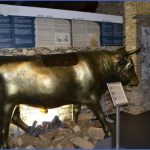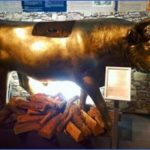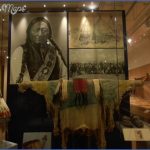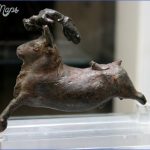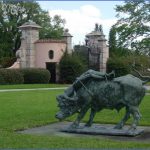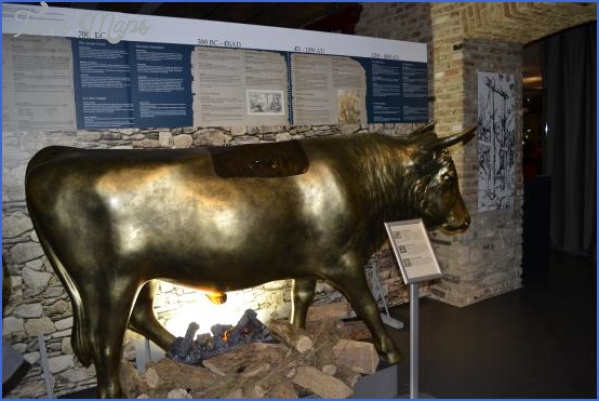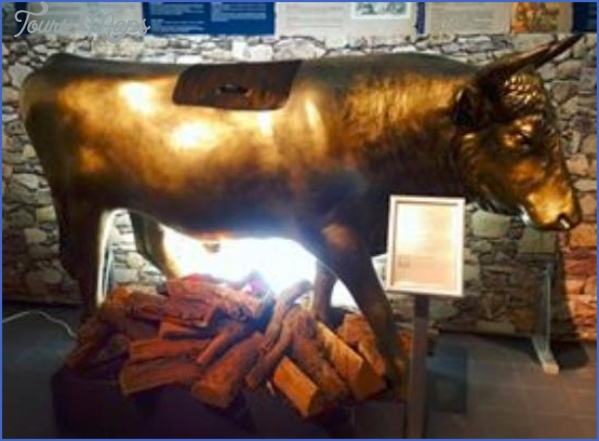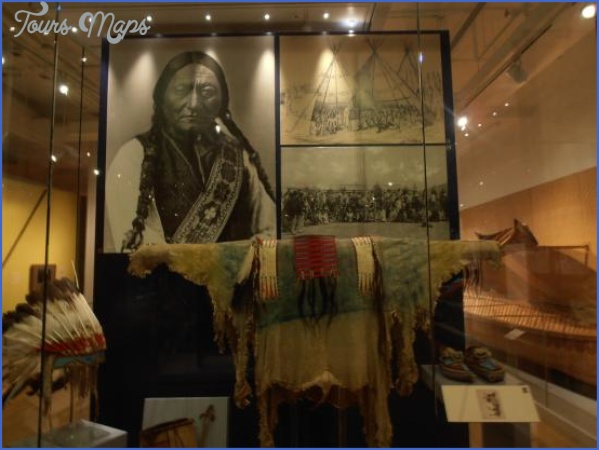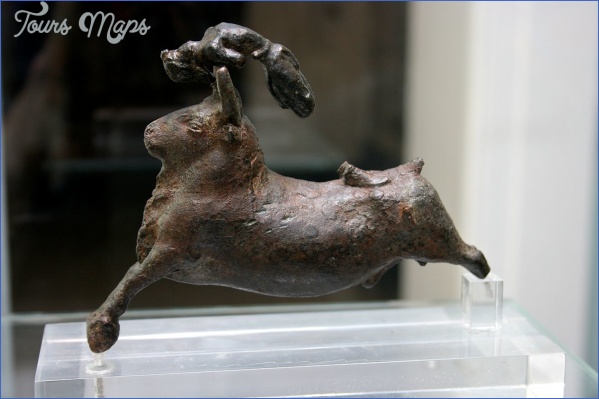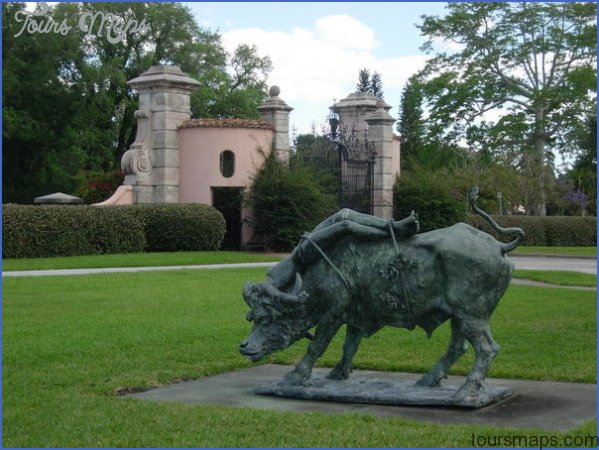BULL MUSEUM
The violinist Ole Bull (1810-80) was a lovable and gifted if quirky character, largely forgotten today despite international fame in his lifetime as a virtuoso and a champion of Norwegian nationalism. He is amply commemorated, both in Norway and in the USA, as well as by diverse writers – Hans Christian Andersen (‘An Episode of Ole Bull’s Life’), George Sand (Malgre tout), Ibsen (Peer Gynt) and Longfellow (Tales of a Wayside Inn). His idiosyncratic playing gained few followers and his naive violin music has not stood the test of time.
While pursuing his own career, Bull championed Norwegian writers and composers, notably Grieg, 33 years his junior. At the age of 40 he established the first Norwegian theatre in his native Bergen, where he is commemorated by a statue and fountain by the sculptor Ambrosia T0nnesen. His hopes of establishing a Norwegian music conservatory in Oslo were realized only in 1883, three years after his death. In his 50s, he built the first of two important houses: the first – still in the family – at Valestrand, north of Bergen, the second a Moorish fantasy on the tiny island of Lys0en, 30 km to the south, which in 1974 was donated to the Norwegian Society for the Preservation of Ancient Monuments and ten years later became a memorial museum.
BULL MUSEUM Photo Gallery
In the 1850s, Ole Bull contemplated American citizenship. Flushed with the success of his concert tours in the USA, he purchased, sight unseen, 17 square miles (44 sq. km) of forestland near the Allegheny Mountains of Pennsylvania, to found a colony of Norwegian settlers, ‘Oleana’. But his settlers began arriving before sensible provision could be made for them and they soon became disenchanted. As many as 300 were attracted to New Norway, the first of three planned villages, founded in September 1852, but after a harsh winter most went wearily on their way, either west to Wisconsin and Minnesota (where, strangely enough, a statue of Ole Bull was erected in a Minneapolis park in 1897) or back to the old Norway. The remaining two villages were never realized, though an ‘Ole Bull Run’ and a two-storey ‘Ole Bull Castle’ evidently were. Bull became involved in another unrealistic scheme in 1855, this time to found an opera company in New York City. But he survived the financial chaos and continued lucrative concert tours during the winters, returning to Norway each summer. Today, in the Kettle Creek Valley of Pennsylvania, all that remains of Oleana is a crossroads in an open field within Ole Bull State Park and a monument erected in 2002. Elsewhere in America, Bull’s portrait hangs at Vesterheim, the Norwegian-American Museum in Decorah, Iowa, and, at the Wayside Inn (of Longfellow fame) in Sudbury, Massachusetts, a small Ole Bull archive (pictures, a signed piece of music and a few mementoes) is faithfully maintained. Ole Bull’s 1687 Stradivarius violin is now in the Herbert R. Axelrod Quartet at the Smithsonian Institution in Washington, DC. From a child prodigy Ole Bull grew into an immensely charismatic and attractive man who never lacked for admirers. In 1836 he married Felicie Villeminot, the granddaughter of his Parisian landlady. Their son, Alexander, inherited the summer estate at Valestrand, which passed through his sister’s children to the present heirs. Although not formally open to the public, it can be visited by appointment. From a distance ‘Bullahuset’, atop a hillock, appears relatively conventional, but on closer inspection the pink-painted building turns out to be embellished with green dragons with bright red tongues. Inside, the house offers a clear foretaste of the flamboyance of Lys0en. Passing through the three reception rooms on the ground floor and up the curved pine staircase, the caller comes to two extraordinary rooms. The first, inspired by Italian church architecture, is dominated by a marble fireplace and barley-sugar wood columns supporting scalloped arches. On the bed in the corner is an apparently infamous tiger-skin rug. There are busts of Bull and Grieg and on the desk opposite the bed a statue of Beethoven. Across the hall and through the peaked doors, the second, larger room, with its vaulted wooden ceiling, is dominated by the polar bear rug on the floor and a saddle resting on a stand. Around the walls are photos, lithographs and a large oil portrait of Bull, a portrait of a folk violinist and a map of the USA.
Bull married his second wife in 1870, two years before acquiring the island of Lys0en (Island of Light) and ten years before his death there. Wealthy and American, Sara Chapman Thorp, from Madison, Wisconsin, was 40 years younger than her husband; their only child, Olea, was born in 1871. When Bull Rights were not granted to include these illustrations in electronic media. Please refer to print publication took possession of the 170-acre (70-hectare) fjord island, there were only a few farm buildings on it. The island had once belonged to the Bernadine monks of the medieval abbey Lysekloster. Instead of refurbishing the existing buildings, Bull engaged an architect, Conrad Frederik von der Lippe, and a local carpenter to build a new house of pinewood on the east of the island as a summer retreat. The design incorporated an exotic onion-shaped dome, supported by barley-sugar columns, and intricate trelliswork inside and out. Bull called his exotic villa his ‘little Alhambra’. He financed the project with earnings from his concerts in America but in 1873 sold it to his father-in-law Senator Joseph Thorp who in his will secured Lys0en for his granddaughter Olea, who passed it on to her adopted daughter Sylvea Bull Curtis (born in 1907). Sylvea spent most of her summers on the island before she donated it in 1973.
Based in New England in the winters (at ‘Elmwood’, in Cambridge, Massachusetts, and in West Lebanon, Maine), Ole Bull and his young family returned each year to Norway to spend their summers on the island. Bull mapped it out, planned paths to the two island lakes, bathing houses and gazebos as well as orchards and lily ponds. He acquired boats to ferry his family and friends on visits. His music room today seats more than 100 and is decorated with souvenirs of his concert career. He died in the villa on 17 August 1880 and was accorded a state funeral (then the largest ever), at which Grieg delivered the oration. His grave in Bergen, in the Assistenkirkegarden near the old city gate, is surmounted by a large urn.
Maybe You Like Them Too
- Top 10 Islands You Can Buy
- Top 10 Underrated Asian Cities 2023
- Top 10 Reasons Upsizing Will Be a Huge Travel Trend
- Top 10 Scuba Diving Destinations
- World’s 10 Best Places To Visit

